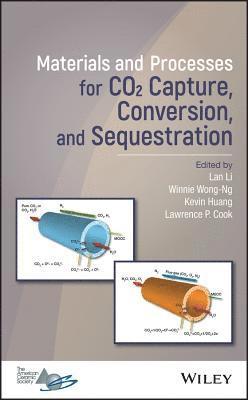
- Format
- Inbunden (Hardback)
- Språk
- Engelska
- Antal sidor
- 384
- Utgivningsdatum
- 2018-10-02
- Förlag
- Wiley-American Ceramic Society
- Medarbetare
- Wong-Ng, W.
- Dimensioner
- 231 x 150 x 23 mm
- Vikt
- Antal komponenter
- 1
- Komponenter
- HC gerader Rücken kaschiert
- ISBN
- 9781119231035
- 726 g
Materials and Processes for CO2 Capture, Conversion, and Sequestration
- Skickas från oss inom 2-5 vardagar.
- Fri frakt över 249 kr för privatkunder i Sverige.
Passar bra ihop
De som köpt den här boken har ofta också köpt Braiding Sweetgrass av Robin Wall Kimmerer (häftad).
Köp båda 2 för 729 krKundrecensioner
Fler böcker av författarna
-
Interfaces in Heterogeneous Ceramic Systems
Lawrence P Cook, Shun-Ichiro Tanaka, Winnie Wong-Ng, Robert W Schwartz
-
Morphotropic Phase Boundary Perovskites, High Strain Piezoelectrics, and Dielectric Ceramics
Ruyan Guo, K M Nair, Winnie Wong-Ng, Amar S Bhalla, Dwight Vieland
-
Processing of High Temperature Superconductors
Amit Goyal, Winnie Wong-Ng, Masato Murakami, Judith Driscoll
Övrig information
LAN (SAMANTHA) LI, PHD, is an assistant professor at the Micron School of Materials Science and Engineering at Boise State University, and an affiliate researcher at the Center for Advanced Energy Studies in Idaho. WINNIE WONG-NG, PHD, FAAAS, FACA, FACERS, and DFICDD, is a research chemist in the Materials Measurement Science Division of the National Institute of Standards and Technology. KEVIN HUANG, PHD, is a SmartState Chair professor in the Mechanical Engineering Department and director at the SmartState Center for Solid Oxide Fuel Cells at the University of South Carolina. LAWRENCE P. COOK, PHD, is a research ordinary professor of chemistry and a lecturer in the Materials Science and Engineering Department at The Catholic University of America in Washington, DC.
Innehållsförteckning
Preface xi List of Contributors xiii 1 CARBON CAPTURE IN METALORGANIC FRAMEWORKS 1 Mehrdad Asgari and Wendy L. Queen 1.1 Introduction 1 1.1.1 The Importance of Carbon Dioxide Capture 1 1.1.2 Conventional Industrial Process of Carbon Capture and Limitations: Liquid Amines 3 1.1.3 MetalOrganic Frameworks and Their Synthesis 4 1.1.4 CCS Technologies and MOF Requirements 6 1.1.5 Molecule Specific 10 1.2 Understanding the Adsorption Properties of MOFs 11 1.2.1 Single-Component Isotherms 11 1.2.2 Multicomponent Adsorption 14 1.2.3 Experimental Breakthrough 15 1.2.4 In Situ Characterization 16 1.3 MOFs for Post-combustion Capture 30 1.3.1 Necessary Framework Properties for CO2 Capture 30 1.3.2 Assessing MOFs for CO2/N2 Separations 32 1.3.3 MOFs with Open Metal Coordination Sites (OMCs) 34 1.3.4 MOFs Containing Lewis Basic Sites 37 1.3.5 Stability and Competitive Binding in the Presence of H2O 45 1.4 MOFs for Pre-combustion Capture 48 1.4.1 Advantages of Pre-combustion Capture 48 1.4.2 Necessary Framework Properties for CO2 Capture 49 1.4.3 Potential MOF Candidates for CO2/H2 Separations 50 1.5 MOFs for Oxy-Fuel Combustion Capture 54 1.5.1 Necessary Framework Properties for O2/N2 Separations 54 1.5.2 Biological Inspiration for O2/N2 Separations in MOFs 55 1.5.3 Potential MOF Candidates for O2/N2 Separations 56 1.6 Future Perspectives and Outlook 61 Acknowledgments 63 References 63 2 METALORGANIC FRAMEWORKS MATERIALS FOR POST-COMBUSTION CO2 CAPTURE 79 Anne M. Marti 2.1 Introduction: The Importance of Carbon Capture and Storage Technologies 79 2.1.1 Post-combustion CO2 Capture Technologies 80 2.1.2 MetalOrganic Frameworks: Potential for Post-combustion CCS 82 2.2 MetalOrganic Frameworks as Sorbents 84 2.2.1 Criteria for Choosing the Best CO2 Sorbent 84 2.2.2 Discussion of Defined Sorbent Criteria 87 2.3 MetalOrganic Framework Membranes for CCS 99 2.3.1 Membrane Performance Defined 99 2.3.2 MOF Membrane Fabrication 102 2.4 Summary 104 References 104 3 NEW PROGRESS OF MICROPOROUS METALORGANIC FRAMEWORKS IN CO2 CAPTURE AND SEPARATION 112 Zhangjing Zhang, Jin Tao, Shengchang Xiang, Banglin Chen, and Wei Zhou 3.1 Introduction 112 3.2 Survey of Typical MOF Adsorbents 116 3.2.1 CO2 Capture and Separation at Low Pressure 116 3.2.2 CO2 Capture and Separation at High Pressure 139 3.2.3 Capture CO2 Directly from Air 140 3.2.4 CO2/CH4 Separation 145 3.2.5 CO2/C2H2 Separation 148 3.2.6 Photocatalytic and Electrochemical Reduction of CO2 149 3.2.7 Humidity Effect 152 3.3 Zeolite Adsorbents in Comparison with MOFs 158 3.4 MOFs Membrane for CCS 163 3.5 Summary and Outlook 165 Acknowledgments 166 References 167 4 IN SITU DIFFRACTION STUDIES OF SELECTED METALORGANIC FRAMEWORK MATERIALS FOR GUEST CAPTURE/EXCHANGE APPLICATIONS 180 Winnie Wong-Ng 4.1 Introduction 180 4.1.1 Background 180 4.1.2 In Situ Diffraction Characterization 181 4.2 Apparatus for In Situ Diffraction Studies 182 4.2.1 Single-Crystal Diffraction Applications 182 4.2.2 Powder Diffraction Applications 185 4.3 In Situ Single-Crystal Diffraction Studies of MOFs 186 4.3.1 Thermally Induced Reversible Single Crystal-to-Single Crystal Transformation 187 4.3.2 Structure Transformation Induced by Presence of Guests 188 4.3.3 Dynamic CO2 Adsorption Behavior 190 4.3.4 Unstable Intermediate Stage During Guest Exchange 190 4.3.5 Mechanism of CO2 Adsorption 192 4.4 Powder Diffraction Studies of MOFs 193 4.4.1 Synchrotron/Neutron Diffraction Studies 193 4.4.2 Laboratory X-ray Diffraction Studies 204 4.5 Conclusion 207 References 207 5 ELECTROCHEMICAL CO2 CAPTURE AND CONVERSION 213 Peng Zhang, Jingjing Tong, and Kevin Huang 5.1 Introduction 213 5.2 Current Electrochemical Methods for Carbon Capture and Conversion 214 5.2.1 Ambient-Temperature Approach 215 5.2.2 High-Temperature Approach 218 5.3 Development of High-Temper


